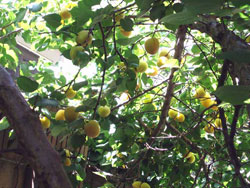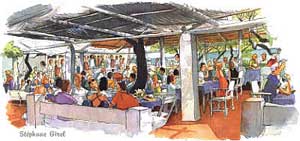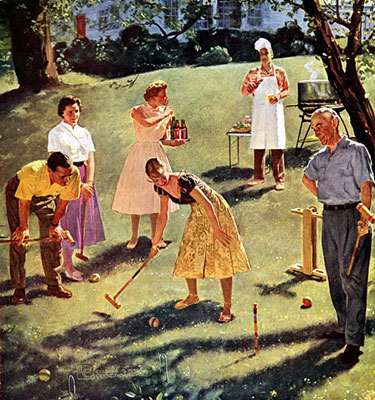 After spending years in the political closet (one of the dangers of a politically mixed marriage) I have emerged with a flourish, and a job as Press Person for a Michigan candidate for the United States House of Representatives. I have been working for Bob Alexander, a Democrat running in Michigan’s 8th Congressional District, against Mike Rogers, a four-term Republican incumbent. Bob is the kind of Democrat my parents are – a Joan Baez, “if you want peace, work for justice” kind of guy who spent years circulating petitions and working crowds “cold” to promote the value of a living wage for working people, and eventually persuaded the Michigan legislature to raise the minimum wage by 29 percent. He was not holding office at the time, mind you; it was just the right thing to do.
After spending years in the political closet (one of the dangers of a politically mixed marriage) I have emerged with a flourish, and a job as Press Person for a Michigan candidate for the United States House of Representatives. I have been working for Bob Alexander, a Democrat running in Michigan’s 8th Congressional District, against Mike Rogers, a four-term Republican incumbent. Bob is the kind of Democrat my parents are – a Joan Baez, “if you want peace, work for justice” kind of guy who spent years circulating petitions and working crowds “cold” to promote the value of a living wage for working people, and eventually persuaded the Michigan legislature to raise the minimum wage by 29 percent. He was not holding office at the time, mind you; it was just the right thing to do.
Ecology
Ecology
Reducing your Carbon Footprint in 2008
 Here are four things you can do to reduce your carbon footprint in 2008.
Here are four things you can do to reduce your carbon footprint in 2008.
1) Buy a Terra Pass at: http://www.terrapass.com
You can get one to offset your automobile, air travel, home energy use…or all three!
2) Cut down on your electric bill by turning off the lights or appliances that are not in use, or if you are in the market for a new appliance, buy one with a high energy star rating.
3) Get out of your car! Ride a bike, if weather & fitness permit. Take public transportation, if it’s available near you.
4) Buy compact fluorescent bulbs for as many lights in your house as you can. You’ll save power, AND some money!
Happy New Year!
Ed
A Tree Grows in Mid-City
 A few years ago I noticed that a tree was growing in the tiny side area between my house and my neighbor’s. By the time I took notice of it the tree was 4 feet tall. Apparently I had been ignoring that side of the house. I don’t know a lot about trees but it looked like it might be some kind of fruit tree. So I waited and asked my gardener. Sure enough, it turned out to be an apricot tree. Since the window above my kitchen sink is right above where the tree has taken root I figured that I must have spit an apricot seed out of the louvers.
A few years ago I noticed that a tree was growing in the tiny side area between my house and my neighbor’s. By the time I took notice of it the tree was 4 feet tall. Apparently I had been ignoring that side of the house. I don’t know a lot about trees but it looked like it might be some kind of fruit tree. So I waited and asked my gardener. Sure enough, it turned out to be an apricot tree. Since the window above my kitchen sink is right above where the tree has taken root I figured that I must have spit an apricot seed out of the louvers.
Yeah, it was a barbarian move, what can I say? But it was a Blenheim pit, so I decided to let the tree stay even though I was told that since it wasn’t a “grafted” tree and without a strong rootstock it probably woudn’t bear fruit. And for 5 years it didn’t, except for a few lonely guys who would appear each year on one branch. They were the few, the brave, and the delicious. Meanwhile, one year the tree trunk split nearly down to the ground. We shored it up and figured that there would be attrition, but no, the tree thrived.
The Future of Food
 The future of our food system is at a critical juncture, says Arty Mangan, Food and Farming Program Director for Bioneers. “The industrial agriculture industry says that they want to feed the world, but at what cost?”
The future of our food system is at a critical juncture, says Arty Mangan, Food and Farming Program Director for Bioneers. “The industrial agriculture industry says that they want to feed the world, but at what cost?”
The cost Mangan is referring to is the system of subsidies that eliminates crop diversity, cost structures that force out small farmers, international trade agreements that favor free flow of grain over local food security, and farming methods that favor profit over food safety or environmental health.
“The system has been rewarding the wrong thing,” Mangan concludes.
One of the main methods being used to transform our food system is localization. The power of localization becomes clear when discussing the “multiplier effect.” If a dollar is spent at a chain store to buy imported produce, only about ten cents ends up in the local community. In contrast, if a dollar is spent at a local market buying locally produced food, that dollar ends up generating over $5 in local benefits.
The Smart Car
 Around 6 years ago, our family took a trip to France. Our friends
have a house in Ramtuelle, a Medieval city built in a circle
overlooking the sparkling Mediterranean. Honest, it does sparkle. We
frolicked on Pamelonne Beach, made famous by the production company
filming And God Created Woman with Brigitte Bardot and we ate at Club
Cinquante Cinque (55).
Around 6 years ago, our family took a trip to France. Our friends
have a house in Ramtuelle, a Medieval city built in a circle
overlooking the sparkling Mediterranean. Honest, it does sparkle. We
frolicked on Pamelonne Beach, made famous by the production company
filming And God Created Woman with Brigitte Bardot and we ate at Club
Cinquante Cinque (55).
You know how you often hear “oh, the restaurant’s right on the beach”? Well, Club Cinquante Cinque (55), really, really IS right on the beach. Sitting around a large table in the canvas-shaded patio of this beautiful place, we had no idea how hard it was to get a reservation. Our girls, aged 12 and 7, adapted to the lifestyle like seasoned European travelers. The kids ate everything that came to the table. Fried smelt were eaten like potato chips…that is, until the real thing came along (one of the restaurant’s specialties). Lena and Hannah devoured catch of the day and seasonal vegetables such as artichokes without the usual suspicion, wrinkled noses and coaxing. Score! After 2 weeks in Ramatuelle, we went off to Paris.
More Articles ...
Welcome to the new One for the Table ...
Our Home Page will be different each time you arrive.
We're sure you'll find something to pique your interest...


